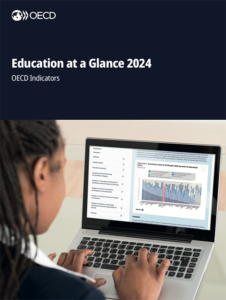
The OECD’s Education at a Glance report is a global assessment that each year compares the educational systems of its member countries. It analyses a wide range of education-related indicators, such as access, resources invested, student performance, and employment outcomes of graduates. The need for improvements in equity has been a constant across all editions of this publication, which has been released annually since 1992 and has become a global reference for evaluating and comparing the educational systems of OECD member countries.
Below, we will examine the main findings of the latest edition, that of 2024, which, as we have mentioned, specifically focuses on educational equity, the disparities occurring within education systems, and the outcomes they generate, both socially and in the labour market.
More schooling but worse learning outcomes
The OECD report highlights significant progress in reducing the number of students prematurely leaving the education system. Since 2016, the proportion of young people aged between 18 and 24 who are neither employed nor in education or training (the so-called NEETs) has fallen from 16% to 14% on average across OECD countries.
There has also been a decrease in the proportion of young people (aged 25 to 34) without an upper secondary education qualification, which fell from 17% in 2016 to 14% in 2023. This achievement has improved employment prospects for this group, with employment rates rising from 59% to 61%. These advances demonstrate that staying in the education system is key to improving job opportunities. Those who complete at least upper secondary education have a higher probability of employment, better incomes, and greater career stability. This underscores the importance of continuing to implement educational policies that address school dropouts and promote the completion of secondary education, especially among the most vulnerable groups.
These results reveals a worrying disconnect between the time students spend in the education system and the quality of the learning acquired.
However, while these advances in educational participation are encouraging, they have not necessarily translated into better learning outcomes. The report highlights that the proportion of 15-year-old students with low performance in Mathematics, Reading, and Science, according to the Programme for International Student Assessment (PISA), has not improved since 2012 in many countries. This reveals a worrying disconnect between the time students spend in the education system and the quality of the learning acquired.
Family background: a lifelong burden
Despite the achievements mentioned, educational inequalities continue to be a challenge at various levels of the system. For example, the report highlights that family background remains one of the most significant determinants of educational success. In many countries, children from low-income families are 18 percentage points less likely to be enrolled in early childhood education programmes before the age of three, compared to their peers from higher-income families. This unequal access to early childhood education has a lasting impact throughout students’ academic lives, hindering their success in primary, secondary, and even higher education.
These inequalities create a vicious circle of intergenerational disadvantages. Only 19% of students whose parents did not complete upper secondary education manage to obtain a tertiary qualification, compared to 72% of those whose parents have a university degree. This perpetuates barriers to social mobility and exacerbates economic and social inequalities.
Only 19% of students whose parents did not complete upper secondary education manage to obtain a tertiary qualification, compared to 72% of those whose parents have a university degree.
Early childhood education: key to reducing inequalities
One of the most effective ways to reduce educational inequalities is to invest in early childhood education. This stage is crucial to closing developmental gaps between children before they enter primary school. Recognising this importance, many OECD countries have implemented policies extending the obligation for preschool education. In fact, in the last decade, 10 out of 38 OECD countries have lowered the starting age for compulsory education, and in 19 countries, preschool education is now mandatory.
Public spending on early childhood education has grown significantly, increasing by an average of 9% between 2015 and 2021 in OECD countries. In some countries, such as Lithuania and Germany, spending has risen by 50% and 42%, respectively, giving us an idea of the growing recognition of the importance of this educational stage for personal and academic development.
Despite this data, disparities in access and affordability of early childhood education remain, especially for low-income families. Although some countries offer free education from an early age, in many others, there are considerable gaps between the end of paid parental leave and the start of free education, forcing families to bear the costs of early childhood education for several years. These economic barriers perpetuate inequalities from the earliest stages of life.
The shortage of qualified teachers: a challenge for equity
The shortage of qualified teachers continues to pose a significant barrier to educational equity. According to the report, at the beginning of the 2022-2023 academic year, 18 out of 21 OECD countries with available data reported suffering from a lack of teachers to fill vacancies in their education systems.
Schools in socioeconomically disadvantaged areas are the most affected by this shortage, exacerbating existing inequalities. Students in these areas not only face disruptions in their learning but also have less access to the individualised attention they need to reach their full potential. Some countries have implemented financial incentives to attract teachers to schools that need them the most, but the report highlights that economic measures alone are not enough. It is necessary to provide professional support and create working conditions that motivate teachers to work in these challenging contexts.
Gender inequalities in the labour market, despite educational achievements
The report also highlights gender disparities in educational achievements and employment opportunities. Although women outperform men in nearly all educational indicators, this advantage does not translate into better job opportunities. On average, women with university education have lower employment rates than men and earn 17% less than their male colleagues with the same qualifications.
This disparity underscores the urgency of policies promoting gender equality both in education and in employment. Removing structural barriers limiting women’s labour force participation, such as wage discrimination or caregiving responsibilities, is key to ensuring that educational achievements translate into equal opportunities in the job market.
We must truly commit to equity
Despite advances in access to education, ensuring that all students have the same opportunities for success remains a significant challenge. Investing in early childhood education, improving conditions for teachers, and supporting disadvantaged students are essential measures to move towards greater educational equity. Moreover, it is vital to implement integrated policies that promote gender equality in the labour market so that educational achievements can translate into a more just and equitable future for all.
Educational equity is not just a desirable goal but a fundamental condition for sustainable development and social cohesion in our societies. To overcome it, continuous commitment is required, both from governments and institutions, ensuring that all students, regardless of their socioeconomic background or gender, can reach their full potential.






